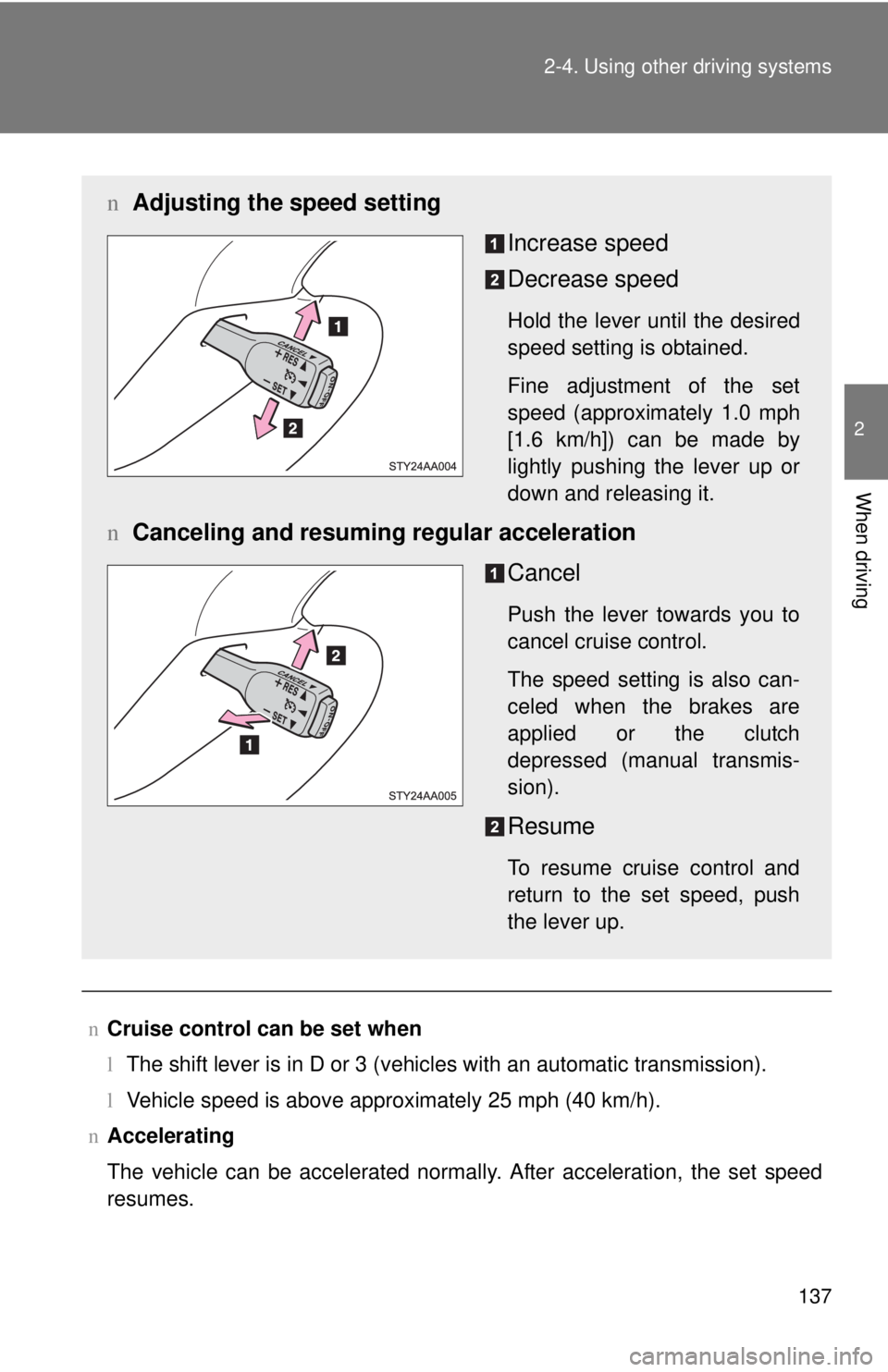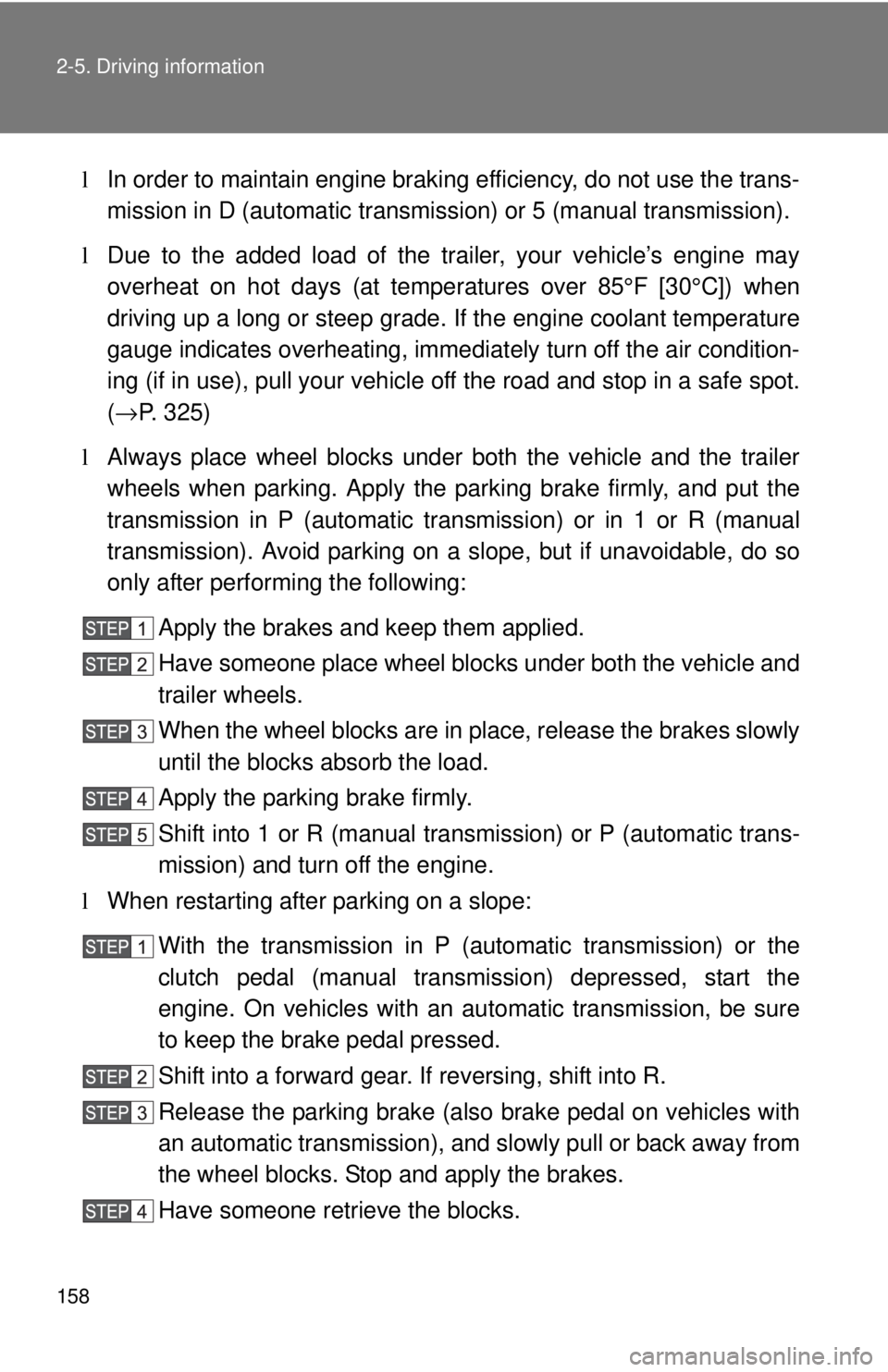2010 TOYOTA YARIS SEDAN clutch
[x] Cancel search: clutchPage 150 of 386

137
2-4. Using other
driving systems
2
When driving
nCruise control can be set when
lThe shift lever is in D or 3 (vehicles with an automatic transmission).
l Vehicle speed is above approximately 25 mph (40 km/h).
n Accelerating
The vehicle can be accelerated normally. After acceleration, the set speed
resumes.
n Adjusting the speed setting
Increase speed
Decrease speed
Hold the lever until the desired
speed setting is obtained.
Fine adjustment of the set
speed (approximately 1.0 mph
[1.6 km/h]) can be made by
lightly pushing the lever up or
down and releasing it.
nCanceling and resuming regular acceleration
Cancel
Push the lever towards you to
cancel cruise control.
The speed setting is also can-
celed when the brakes are
applied or the clutch
depressed (manual transmis-
sion).
Resume
To resume cruise control and
return to the set speed, push
the lever up.
Page 159 of 386

146 2-5. Driving information
CAUTION
nThings that must not be carried in the trunk
The following things may cause a fire if loaded in the trunk.
lReceptacles containing gasoline
lAerosol cans
nStorage precautions
Observe the following precautions.
Failing to do so may result in death or serious injury.
lDo not place cargo or luggage in or on the following locations as the
item may get under the clutch, brake or accelerator pedal and prevent
the pedals from being depressed properly, block the driver’s vision, or
hit the driver or passengers, causing an accident.
• Driver’s feet
• Front passenger or rear seats (when stacking items)
• Package tray
• Instrument panel
• Dashboard
• Auxiliary box or tray that has no lid
lSecure all items in the occupant compartment, as they may shift and
injure someone during emergency braking, sudden swerving or an
accident.
lNever allow anyone to ride in the enlarged trunk. It is not designed for
passengers. They should ride in their seats with their seat belts prop-
erly fastened. Otherwise, they are much more likely to suffer death or
serious bodily injury, in the event of emergency braking, sudden
swerving or an accident.
nCapacity and distribution
lDo not exceed the maximum axle weight rating or the total vehicle
weight rating.
lEven if the total load of occupant’s weight and the cargo load is less
than the total load capacity, do not apply the load unevenly. Improper
loading may cause deterioration of steering or braking control which
may cause death or serious injury.
Page 171 of 386

158 2-5. Driving information
lIn order to maintain engine braking efficiency, do not use the trans-
mission in D (automatic transmission) or 5 (manual transmission).
l Due to the added load of the trailer, your vehicle’s engine may
overheat on hot days (at temper atures over 85°F [30°C]) when
driving up a long or steep grade. If the engine coolant temperature
gauge indicates overheating, immediately turn off the air condition-
ing (if in use), pull your vehicle off the road and stop in a safe spot.
( → P. 325)
l Always place wheel blocks under both the vehicle and the trailer
wheels when parking. Apply the parking brake firmly, and put the
transmission in P (automatic transmission) or in 1 or R (manual
transmission). Avoid parking on a slope, but if unavoidable, do so
only after performing the following:
Apply the brakes and keep them applied.
Have someone place wheel bloc ks under both the vehicle and
trailer wheels.
When the wheel blocks are in place, release the brakes slowly
until the blocks absorb the load.
Apply the parking brake firmly.
Shift into 1 or R (manual transmission) or P (automatic trans-
mission) and turn off the engine.
l When restarting after parking on a slope:
With the transmission in P (automatic transmission) or the
clutch pedal (manual transmission) depressed, start the
engine. On vehicles with an au tomatic transmission, be sure
to keep the brake pedal pressed.
Shift into a forward gear. If reversing, shift into R.
Release the parking brake (also brake pedal on vehicles with
an automatic transmission), and slowly pull or back away from
the wheel blocks. Stop and apply the brakes.
Have someone retrieve the blocks.
Page 235 of 386

224 4-2. Maintenance
Vehicle interior
ItemsCheck points
Accelerator pedal • Moves smoothly (without uneven
pedal effort or catching)?
Automatic transmission “Park”
mechanism • Can the vehicle be hold securely
on an incline with the shift lever in
P?
Brake pedal • Moves smoothly?
• Does it have appropriate clear-
ance and correct amount of free
play?
Brakes • Not pull to one side when
applied?
• Loss of brake effectiveness?
• Spongy feeling brake pedal?
• Pedal almost touches floor?
Clutch pedal • Moves smoothly?
• Does it have correct amount of
free play?
Head restraints • Move smoothly and lock
securely?
Indicators/buzzers • Function properly?
Lights • Do all the lights come on?
• Headlights aimed correctly?
Parking brake • Moves smoothly?
• Can hold the vehicle securely on
an incline?
Seat belts • Does the seat belt system oper-
ate smoothly?
• Are the belts undamaged?
Seats • Do the seat controls operate
properly?
Page 348 of 386

339
6-1. Specifications
6
Vehicle specifications
Automatic transaxle
*: The fluid capacity is the quantity of reference.
If replacement is necessary, contact your Toyota dealer.
Manual transaxle
Clutch
Fluid capacity*6.8 qt. (6.4 L, 5.6 Imp.qt.)
Fluid type Toyota Genuine ATF WS
NOTICE
nAutomatic transmission fluid type
Using automatic transmission fluid other than “Toyota Genuine ATF WS”
may cause deterioration in shift quality, locking up of your transmission
accompanied by vibration, and ultimately damage the automatic transmis-
sion of your vehicle.
Gear oil capacity (Reference) 2.0 qt. (1.9 L, 1.7 Imp.qt.)
Gear oil type Gear oil API GL-4 or GL-5
Recommended gear oil
viscosity SAE 75W-90
Clutch free play
0.2 ⎯ 0.6 in. (5 ⎯ 15 mm)
Fluid type FMVSS No.116 DOT 3 or SAE J1703
Page 376 of 386

370 Alphabetical index
Child restraint systemBooster seats, definition ..........86
Booster seats, installation .......90
Convertible seats, definition ....86
Convertible seats,
installation .............................90
Front passenger occupant classification system .............81
Infant seat, definition ...............86
Infant seats, installation...........90
Installing CRS with LATCH system ..................................91
Installing CRS with seat belts ......................................92
Installing CRS with top tether straps ..........................96
Child safety
Airbag precautions ..................76
Battery precautions ....... 243, 323
Child restraint syst em..............86
Child-protectors .......................31
How your child should wear the seat belt ..........................48
Installing child restraints ..........90
Power window lock switch.......57
Power window precautions .....57
Removed key battery precautions ......................... 262
Seat belt extender
precautions ...........................50
Seat belt precautions ..............48
Trunk precautions ...................35
Child-protectors .........................31
Cigarette lighter ....................... 210
Cleaning Exterior .................................. 216
Interior ................................... 218
Seat belts .............................. 219
Clock ..................................121,208
Clutch Fluid ...................................... 339
Pedal ..............................100,116
Condenser ................................ 240 Console box ............................. 201
CRS ............................................. 86
Cruise control
Cruise control ........................ 136
Indicator ................................ 136
Cup holders .............................. 202
Curtain shield airbags ............... 69
Customizable features ............ 359
Daytime running light system .................................... 131
Defogger Rear window ......................... 170
Side mirrors........................... 170
Dimension ................................ 332
Do-it-yourself maintenance .... 227
Doors Door glasses ........................... 56
Door lock ................................. 28
Side doors ............................... 28
Side mirrors............................. 53
Warning light ......................... 300
Driver's seat belt reminder light ......................................... 300
Driving
Break-in tips .......................... 102
Correct posture ....................... 67
Procedures............................ 100
Winter driving tips ................. 148
Electric power steering Electric power steering.......... 139
Warning light ......................... 298
Emergency flashers Switch ................................... 286
Emergency, in case of
If the engine will not start ...... 318
If the shift lever cannot be shifted from P ..................... 320
If the vehicle battery is discharged .......................... 322
D
E
Page 377 of 386

371
Alphabetical index
If the warning buzzer
sounds ............................... 297
If the warning light turns on .. 297
If you have a flat tire ............ 307
If you lose your keys............. 321
If you think something is wrong ................................. 293
If the vehicle becomes
stuck................................... 328
If your vehicle has to be stopped in an emergency... 330
If your vehicle needs to be towed ................................. 287
If your vehicle overheats ...... 325
Engine Compartment........................ 234
Engine switch ....................... 110
Hood ..................................... 231
How to start the engine ........ 110
Identification number ............ 334
If the engine will not start...... 318
Ignition switch ....................... 110
Immobilizer system................. 62
Overheating .......................... 325
Specifications ....................... 335
Warning light ........................ 298
Engine coolant Capacity ............................... 337
Checking .............................. 239
Indicator................................ 126
Preparing and checking before winter ...................... 148
Type ..................................... 337
Warning light ........................ 298
Engine immobilizer system ...... 62
Engine oil
Capacity ............................... 336
Checking .............................. 235
Grade ................................... 336
Initializing the maintenance data .................................... 237
Preparing and checking before winter ...................... 148 Warning light .........................298
Engine switch ...........................110
Engine oil maintenance
data .........................................237
EPS
EPS .......................................139
Warning light .........................298
Event data recorder .................295
Floor mat...................................213
Fluid
Automatic transmission .........339
Brake .....................................240
Clutch ....................................339
Warning light .................297, 300
Washer ..................................244
Fog lights Indicator ................................132
Replacing light bulbs .............274
Switch....................................132
Wattage .................................342
Front fog lights
Indicator ................................132
Replacing light bulbs .............274
Switch....................................132
Wattage .................................342
Front passenger's seat belt reminder light.........................300
Front seats Adjustment ..............................37
Front side marker lights
Replacing light bulbs .............274
Switch....................................130
Wattage .................................342
Front turn signal lights Indicator ................................117
Lever .....................................117
Replacing light bulbs .............274
Switch....................................117
Wattage .................................342
Fuel Capacity ................................335
Fuel pump shut off system ....294
F